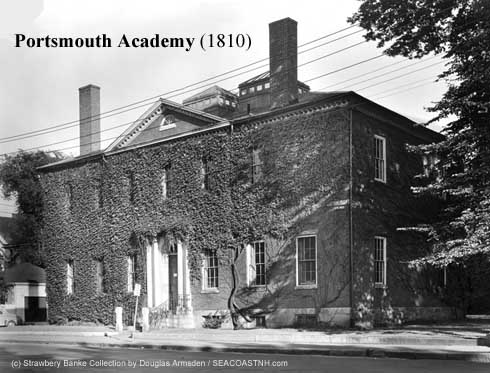|
FRESH STUFF DAILY |
|
|
||
|
|
||
|
|
||
|
SEE ALL SIGNED BOOKS by J. Dennis Robinson click here |
||
Page 3 of 4
-- The City of Portsmouth first leased the Academy building in 1868 and used it as the Jones Grammar School. Frank Jones, the "ale tycoon" was then mayor. Jones, a millionaire, also donated his $500 salary as mayor as seed money to create a public library for the city, and challenged others to build up a fund of $5,000. -- A few years later the Jones School was condemned as unsafe and unsanitary. Curiously, Dr. Henry E. Clark, who forced the closure of the school, lived right next door in the brick house built by Thomas Morton in 1810. – In 1871, inspired by a sermon at the South Church, the Young People’s Union was created to provide a library and youth center for local teens. Three rooms were set aside at the corner of Vaughan and Congress streets. Technically, this was the birth of the Portsmouth Public Library. When the group folded a few years later the books were stored, temporarily, in the basement of the Unitarian Chapel. -- In 1881 the books from the Young People’s Union were made available to the public in one room on the top floor of the old Custom House. The city took responsibility for the collection and hired a librarian to catalog the books. The collection was moved twice more before finding a permanent home in the old Academy building. Hon. Frank Jones’ $500 bequest grew, with contributions, to over $10,000. A number of private book collections were donated to the growing library shelves. -- While the public library was evolving elsewhere, a group of Civil War veterans and friends leased the old Academy. The Storer Post of the Grand Army of the Republic (G.A.R.) planned to create a Memorial Hall. Almost immediately, the city began to negotiate with the Storer Post about taking over their lease and sharing the building as both a library and an exhibit hall. When the city was slow to renovate the building, the GAR sued the city and won $5,000 to break its lease. -- After paying off the Storer Post, the city took over the lease on the Academy for a library. They gutted it, and rebuilt the interior for about $5,500. A glass skylight was added to illuminate the interior. The PPL occupied the building in 1896, purchased it officially in 1906 and stayed until the new library building opened on Parrott Ave. in 2006. There have been only six city librarians in that entire time. -- Meanwhile, one doctor after another occupied an office that had been added to the old Morton house next door. By the early 20th century, after many owners and many tenants, the house was purchased by the Benedict family. One of their renters turned the doctor’s office into "Mirriam’s Tea Room" in the 1920s. The house included a dentist’s office in the 1930s. -- In 1949 the Morton-Benedict House was sold at auction and by 1950 the ivy-covered brick residence was unoccupied. By this time the library next door was severely overcrowded and looking to expand. -- In 1951 the city purchased the Morton-Benedict House as the library "annex" and a few years later linked it to the Academy building with a one-story brick addition. The architect also created an opaque glass floor in the center of the Academy building that allowed light from the skylight to filter down to the first floor of the library. CONTINUE CULTURAL CENTER Please visit these SeacoastNH.com ad partners.
News about Portsmouth from Fosters.com |
| Friday, April 19, 2024 |


|
Copyright ® 1996-2020 SeacoastNH.com. All rights reserved. Privacy Statement
Site maintained by ad-cetera graphics

 HISTORY
HISTORY



















